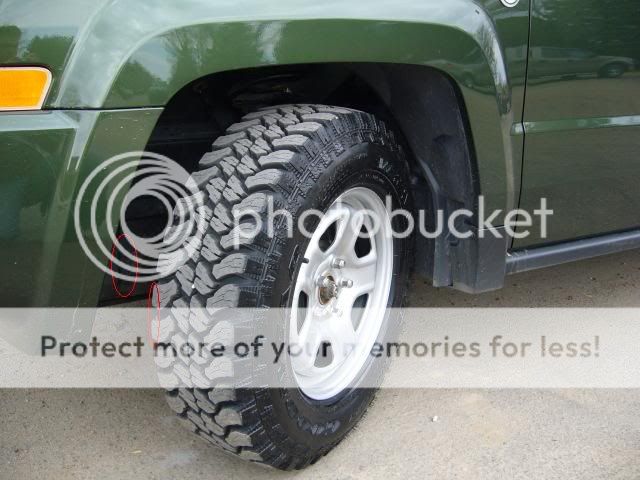So after being torn on what tire to get, the final straw came when crappy tire had their buy 1 get 1 for 1/2 price deal.
I decided to go with the Goodyear Wrangler Territory in LT225/75/16
Here's the specs of my jeep:
Stock height FDII using the patriot 16" steel wheels.
As you can see in the pictures no problems clearance wise on the spring perch as well as that little piece of plastic in the wheel well.
They do rub at full lock although since they clear the above mentioned obstacles I don't know where it is rubbing, not a big deal at all and it doesn't bother me either.
In terms of ride and handling, they are loud, not like a humming loud but its more of a whoosh type sound, similar to a set of winter tires I had on a previous vehicle. The noise isn't that bad altough for a daily driver some people might find it a bit much. They are heavier than the stock setup although I havn't noticed any adverse effects. Speedo is off I presume but not a big deal either.
As for performance offroad, they have been on for about 2 hours, and as you can see my Pat is rather clean at the moment, later tonight or tomorrow i'll go hunting for some mud to see how they perform.
So in my opinion, 225/75/16 fit on an unlifted FDII and most likely FDI rather nicely.
![Image]()
![Image]()
![Image]()
![Image]()
![Image]()
![Image]()
![Image]()
![Image]()
![Image]()
![Image]()
Anyone got a set of center caps they want to sell? Or can I just use a set off a libery ect...
I decided to go with the Goodyear Wrangler Territory in LT225/75/16
Here's the specs of my jeep:
Stock height FDII using the patriot 16" steel wheels.
As you can see in the pictures no problems clearance wise on the spring perch as well as that little piece of plastic in the wheel well.
They do rub at full lock although since they clear the above mentioned obstacles I don't know where it is rubbing, not a big deal at all and it doesn't bother me either.
In terms of ride and handling, they are loud, not like a humming loud but its more of a whoosh type sound, similar to a set of winter tires I had on a previous vehicle. The noise isn't that bad altough for a daily driver some people might find it a bit much. They are heavier than the stock setup although I havn't noticed any adverse effects. Speedo is off I presume but not a big deal either.
As for performance offroad, they have been on for about 2 hours, and as you can see my Pat is rather clean at the moment, later tonight or tomorrow i'll go hunting for some mud to see how they perform.
So in my opinion, 225/75/16 fit on an unlifted FDII and most likely FDI rather nicely.










Anyone got a set of center caps they want to sell? Or can I just use a set off a libery ect...








